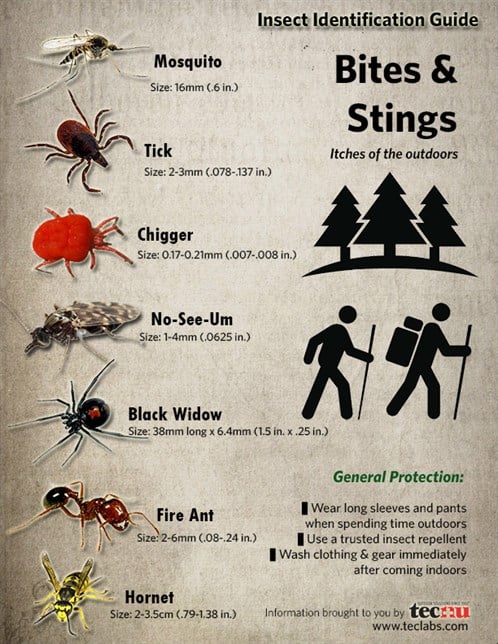
There are a great number of insect species inhabiting the earth. People who frequent the great outdoors for work or fun are likely to encounter one, many, or all of them. To make your outdoors experience more enjoyable, we have list of common insects you are likely to see.
MOSQUITOES
General Information:
Tiny, irritating blood suckers that feast on human blood, and are quite fond of: mammals, birds, reptiles, amphibians, even some kinds of fish Interestingly, mosquitoes use chemical, visual, and heat sensors to find their prey. While both males and females feed on nectars and plants, the females are better equipped to feed on humans and the other species. The intense itching and irritation from a mosquito bite is caused by the insect's saliva.
Diseases
Malaria, Yellow Fever, and most notably, West Nile Virus.
Habitat
Mosquitoes are found throughout the United States. They often prefer areas with stagnant water (within which they lay their eggs). Examples are: ponds, marshes, swamps, and other wetland habitats.
How to Protect Yourself:
- Avoid leaving windows and doors open during the warmer months.
- Wear long sleeves and pants when outdoors during peak mosquito hours (dusk and dawn).
- Do not leave standing water around your home (i.e. buckets, pools, etc.).
- Replace exterior light bulbs with yellow bulbs as mosquitoes are less attracted to them.
- Protect yourself with a trusted insect repellent.
TICKS
General Information:
Ticks are an ever-growing problem in the United States. There are many different species which are capable of spreading harmful diseases. They are fond of both humans and our furry friends, particularly dogs.
Diseases:
Rocky Mountain Spotted Fever & Lyme Disease.
Habitat:
Ticks are found in wooded areas, tall brush/grass, under fallen leaves, under plants and ground cover in your yard, as well as around stone walls and wood piles.
How to Protect Yourself:
- Use an insect repellent designed for use against ticks.
- Complete a full-body check when you come indoors after visiting areas where ticks reside.
- After a full-body check, shower immediately.
- Place appropriate clothing and gear in the dryer on high heat for at least 30 minutes.
CHIGGERS
General Information:
Also known as berry bugs or red bugs, chiggers belong to a mite family of approximately 30 different species. Chiggers only feast on humans during the larval stage. Bites can cause red welts coupled with intense itching. They are typically found near the waist, ankles, and in warm skin folds. Once they've fed on their host, they drop to the ground and become nymphs, eventually maturing into adults. When they've reached adulthood, chiggers are no longer harmful to humans.
Diseases:
Do not typically carry diseases in North America.
Habitat:
Chiggers are found in forests, grasslands, in vegetation of low, damp areas, along lakes and streams, in lawns and parks.
How to Protect Yourself:
- Use an insect repellent indicated for use against chiggers.
- If you plan to be outdoors for an extended period of time, wear long sleeves and pants.
- Once you are back indoors, immediately take a hot shower. Launder your clothing, preferably in warm/hot water, high heat in the dryer.
FIRE ANTS
General Information:
Fire ants are named for their reddish-brown appearance and painful sting that will send you running for your mom. (Just kidding… kind of). These nasty little critters look just like your standard black ants. But ordinary, they are not! If threatened, fire ants bite (only for grip) then sting to inject alkaloid venom that causes a painful, burning sensation. Unlike many insects, fire ants do not hibernate, and can survive extreme weather conditions.
Diseases:
No known to carry any diseases.
Habitat: Fire ants prefer to build their mounds in open areas with access to lots of sunlight such as: meadows, pastures, parks, playgrounds, lawns, golf courses, as well as agricultural areas.
How to Protect Yourself:
- Keep an eye out for ant hills or mounds & avoid them!
- Wear shoes as often as possible when spending time outdoors.
NO-SEE-UMS
General Information:
These tiny insects named for their microscopic size are nearly impossible to see at a whopping 1/16th of an inch. So small in fact, they could fit through a window screen! Like mosquitoes, only the females are equipped to bite and feed on blood. No-see-ums are an issue during the warmer spring months when they begin breeding. The need a blood meal to complete the reproductive cycle. This can last for several weeks. The bite of a no-see-um causes intensely itchy red welts that can last for a week or more.
Diseases:
They can spread protozoa or filarial worms in tropical regions.
Habitat:
Found in almost any aquatic and semiaquatic habitat throughout the world. They can also be found in mountain ranges, beaches, and grassy areas.
How to Protect Yourself:
- Avoid sitting directly on grass during the spring months.
- Use an insect repellent indicated for use against no-see-ums.
- When you return indoors, immediately wash clothing in warm/hot water and dry on high heat.
- Shower immediately after coming indoors.
SPIDERS
General Information:
According to the Mayo Clinic, there are only a few spiders that pose a threat to humans. Two found throughout the U.S. include the black widow spider and the brown recluse. (Although they are more common in the southern states.) Bites from either spider can cause a number of symptoms including chills, fever, nausea, vomiting, and abdominal pain. If bitten, the May Clinic suggests:
- Cleansing the wound with soap and water.
- If bitten on the arm or leg, tie a bandage above the bite and elevate the affected limb to help stop the venom's spread.
- Apply a cold compress to the bite.
- Seek immediate medical attention. Treatment for a black widow or brown recluse bite may require anti-venom medication.
- Shake off firewood before coming indoors.
Diseases:
Not known to carry diseases.
Habitat:
Spiders prefer warm, dark, dry climates with plenty of food (flies) available. Undisturbed areas are a favorite including but not limited to closets, woodpiles, sheds, corners in the garage, and under sinks.
How to Protect Yourself:
- When working in areas that spiders live, wear long sleeves, pants, and gloves.
- Watch where you place your hands.
- Shake off clothing before you put it on or go inside.
- Sweep, mop, & vacuum webs and spiders regularly.
- In storage areas avoid placing boxes directly against the wall and keep them taped shut.
- Keep clutter and growth clear around the home.
- Routinely spray your home with products indicated for use against spiders.
HORNETS/WASPS
General Information:
Hornets, wasps, & bees are a problem for most people who frequent the outdoors. In most cases a sting or a bite will cause mild pain and irritation. For some, it can cause a deadly allergic reaction. According to the CDC, an estimated 100 people die each year from allergic reactions to bee, wasp, and hornet stings. People who have such an allergy should always carry a doctor prescribed epinephrine auto injector (EpiPen). They should also carry a medical signifier such as a bracelet, card, or necklace.
Diseases:
Not known to carry any diseases.
Habitat:
While found just about anywhere outdoors, flower pollen attracts hornets and wasps. Thus, areas with flowering plants will host a significant number of these insects.
How to Protect Yourself:
- Wear long sleeves and pants, preferably in light colors.
- Sweat and oil can attract these insects. Showering daily and wearing clean clothes is important.
- Clean up food as soon as possible after eating to avoid attracting them to you.
- When attacked by hornets, wasps, or bees, move as soon as possible. Bees release a chemical that attracts fellow bees when they sting. Look for shaded areas, or an indoor location.




